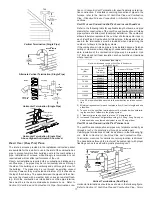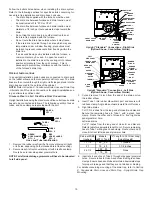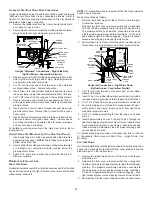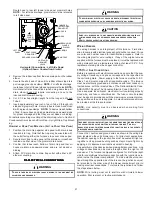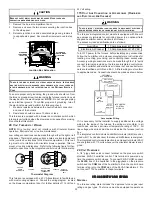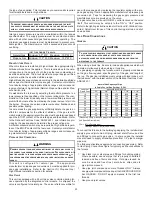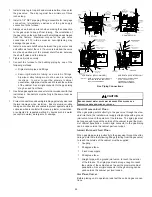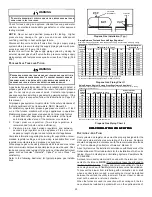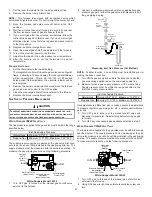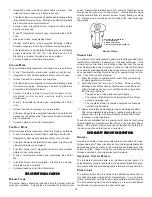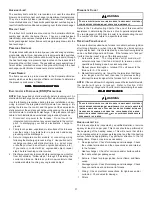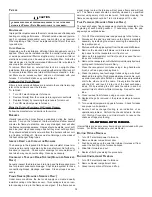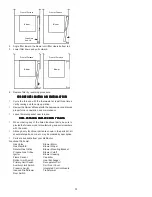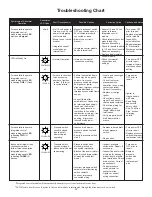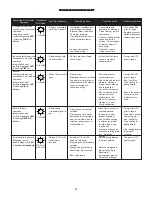
31
A
UXILIARY
L
IMIT
The auxiliary limit control(s) are located on or near the circulator
blower and monitors heat exchanger compartment temperatures.
They are a normally-closed (electrically), manual-reset, tempera-
ture activated sensors. These limits guard against overheating as a
result of insufficient conditioned air passing over the heat exchanger.
R
OLLOUT
L
IMIT
The rollout limit controls are mounted on the burner/manifold as-
sembly and monitor the burner flame. They are normally-closed
(electrically), manual-reset, temperature-activated sensors. These
limits guard against burner flames not being properly drawn into the
heat exchanger.
P
RESSURE
S
WITCHES
The pressure switches are normally-open (closed during operation),
single-pole single-throw, negative air pressure-activated switches.
They monitor the airflow (combustion air and flue products) through
the heat exchanger via pressure taps located on the induced draft
blower and the coil front cover. These switches guard against insuf-
ficient airflow (combustion air and flue products) through the heat
exchanger and/or blocked condensate drain conditions.
F
LAME
S
ENSOR
The flame sensor is a probe mounted to the burner/manifold as-
sembly which uses the principle of flame rectification to determine
the presence or absence of flame.
XVIII. TR
XVIII. TR
XVIII. TR
XVIII. TR
XVIII. TROUBLESH
OUBLESH
OUBLESH
OUBLESH
OUBLESHOO
OO
OO
OO
OOTIN
TIN
TIN
TIN
TING
G
G
G
G
E
LECTROSTATIC
D
ISCHARGE
(ESD) P
RECAUTIONS
NOTE:
Discharge body’s static electricity before touching unit. An
electrostatic discharge can adversely affect electrical components.
Use the following precautions during furnace installation and ser-
vicing to protect the integrated control module from damage. By
putting the furnace, the control, and the person at the same electro-
static potential, these steps will help avoid exposing the integrated
control module to electrostatic discharge. This procedure is appli-
cable to both installed and uninstalled (ungrounded) furnaces.
1.
Disconnect all power to the furnace. Do not touch the
integrated control module or any wire connected to the control
prior to discharging your body’s electrostatic charge to
ground.
2.
Firmly touch a clean, unpainted, metal surface of the furnaces
near the control. Any tools held in a person’s hand during
grounding will be discharged.
3.
Service integrated control module or connecting wiring
following the discharge process in step 2. Use caution not to
recharge your body with static electricity; (i.e., do not move
or shuffle your feet, do not touch ungrounded objects, etc.).
If you come in contact with an ungrounded object, repeat
step 2 before touching control or wires.
4.
Discharge your body to ground before removing a new control
from its container. Follow steps 1 through 3 if installing the
control on a furnace. Return any old or new controls to their
containers before touching any ungrounded object.
D
IAGNOSTIC
C
HART
WARNING
T
O AVOID ELECTRICAL SHOCK, INJURY OR DEATH, DISCONNECT ELECTRICAL
POWER BEFORE PERFORMING ANY SERVICE OR MAINTENANCE.
Refer to the
Troubleshooting Chart
at the end of this manual for
assistance in determining the source of unit operational problems.
The red diagnostic LED blinks to assist in troubleshooting the unit.
The number of blinks refers to a specific fault code.
R
ESETTING
F
ROM
L
OCKOUT
Furnace lockout results when a furnace is unable to achieve ignition
after three attempts, or when it has lost flame five times during a
single call for heat. It is characterized by a non-functioning furnace
and a one flash diagnostic LED code. If the furnace is in “lockout”,
it will (or can be) reset in any of the following ways.
1.
Automatic reset. The integrated control module will
automatically reset itself and attempt to resume normal
operations following a one hour lockout period.
2.
Manual power interruption. Interrupt 115 volt power to the
furnace for 0 - 20 seconds.
3.
Manual thermostat cycle. Lower the thermostat so that there
is no longer a call for heat then reset to previous setting.
Interrupt thermostat signal to the furnace for 0 - 20 seconds.
NOTE:
If the condition which originally caused the lockout still exists,
the control will return to lockout. Refer to
Section XVIII,
Troubleshooting - Diagnostic Chart
for aid in determining the cause.
XIX. MAINTENAN
XIX. MAINTENAN
XIX. MAINTENAN
XIX. MAINTENAN
XIX. MAINTENANCE
CE
CE
CE
CE
WARNING
T
O AVOID ELECTRICAL SHOCK, INJURY OR DEATH, DISCONNECT ELECTRICAL
POWER BEFORE PERFORMING ANY MAINTENANCE. IF YOU MUST HANDLE THE
IGNITER, HANDLE WITH CARE.
T
OUCHING THE IGNITER ELEMENT WITH BARE
FINGERS, ROUGH HANDLING, OR VIBRATION COULD DAMAGE THE IGNITER
RESULTING IN PREMATURE FAILURE.
O
NLY A QUALIFIED SERVICER SHOULD
EVER HANDLE THE IGNITER.
A
NNUAL
INSPECTION
The furnace should be inspected by a qualified installer, or service
agency at least once per year. This check should be performed at
the beginning of the heating season. This will ensure that all fur-
nace components are in proper working order and that the heating
system functions appropriately. Pay particular attention to the fol-
lowing items. Repair or service as necessary.
•
Flue pipe system. Check for blockage and/or leakage. Check
the outside termination and the connections at and internal
to the furnace.
•
Heat exchanger. Check for corrosion and/or buildup within
the heat exchanger passageways.
•
Burners. Check for proper ignition, burner flame, and flame
sense.
•
Drainage system. Check for blockage and/or leakage. Check
hose connections at and internal to furnace.
•
Wiring. Check electrical connections for tightness and/or
corrosion. Check wires for damage.
•
Filters.

